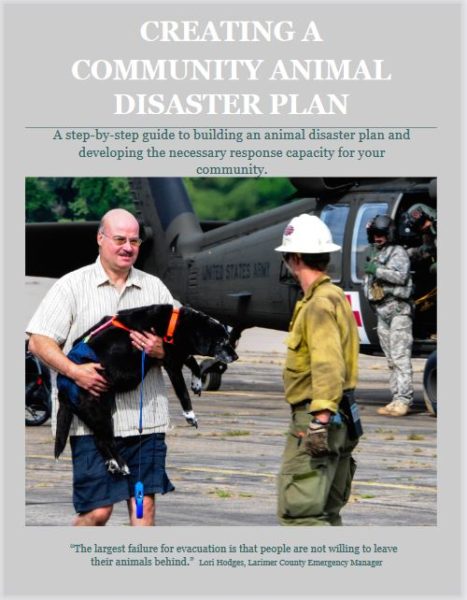As Colorado continues to experience devastating wildfires, many communities are under evacuation orders. If your home is threatened, it’s easy to become overwhelmed with decisions about where to go and what to take. But one thing you should always remember is to do whatever you can to ensure the safety of any animals – whether pets or livestock – that you own or are responsible for.
For evacuees of the East Troublesome and Cameron Peak Fires, sheltering information can be found on the Larimer County Humane Society’s wildfire information page. For those affected by the CalWood and Lefthand Fires, see the Humane Society of Boulder Valley’s website. The State of Colorado also has some helpful online resources that can help animal owners plan for the safety of their pets and livestock.
Livestock and Horses
 Wildfire Preparedness for Horse Owners, a fact sheet from the Colorado State University Extension, offers helpful tips on planning for evacuation, ensuring identification of your horses, and assembling an equine first aid kit. Another Extension publication, Caring for Livestock During Disaster, notes that livestock can be especially sensitive to wildfire smoke and, in response, may panic or attempt to escape. Therefore it is suggested that identification tags be attached to livestock if possible.
Wildfire Preparedness for Horse Owners, a fact sheet from the Colorado State University Extension, offers helpful tips on planning for evacuation, ensuring identification of your horses, and assembling an equine first aid kit. Another Extension publication, Caring for Livestock During Disaster, notes that livestock can be especially sensitive to wildfire smoke and, in response, may panic or attempt to escape. Therefore it is suggested that identification tags be attached to livestock if possible.
Additional tips can be found in ReadyColorado’s brochure, Plan for Livestock in Advance of An Emergency. If the fire gets too close, livestock may require special rescue operations. If you need assistance, contact your county emergency responders or your local humane society (listed above for the current fires).
Pets
When evacuating, it’s important to remember not only to grab your pets, but also to pack food and emergency supplies for them as well. Colorado State University suggests preparing a “ready-to-go bag” for your pets in advance of an evacuation order, including
- Food, water and medications for three days
- Copies of vaccination records and medical histories
- List of important animal emergency contacts, such as the names and locations of veterinary offices
- Collars with tags and microchip information
- Photos of you with your pet
- Bowls, can openers, spoons
- Cat litter, scoop and pan
- Pet first-aid kit
- Bedding, crate or carrier
- Leashes, harnesses
- Toys, grooming supplies
- Paper towels, trash bags, disinfectant
- Towels, gloves and hand sanitizer
Community Animal Disaster Planning
 Thanks to the 2006 Pets Evacuation and Transportation Standards (PETS) Act, federal financial assistance is available to communities with emergency plans that address the needs of individuals with household pets or service animals. Creating a Community Animal Disaster Plan is a publication from Colorado State University that can offer helpful information on planning. For more on this topic, see my previous blog post.
Thanks to the 2006 Pets Evacuation and Transportation Standards (PETS) Act, federal financial assistance is available to communities with emergency plans that address the needs of individuals with household pets or service animals. Creating a Community Animal Disaster Plan is a publication from Colorado State University that can offer helpful information on planning. For more on this topic, see my previous blog post.
- How to Spot the Differences Between Eagles and Hawks - August 16, 2021
- How Transportation Projects Help Tell the Story of Colorado’s Past - August 9, 2021
- Time Machine Tuesday: The Night the Castlewood Canyon Dam Gave Way - August 3, 2021
